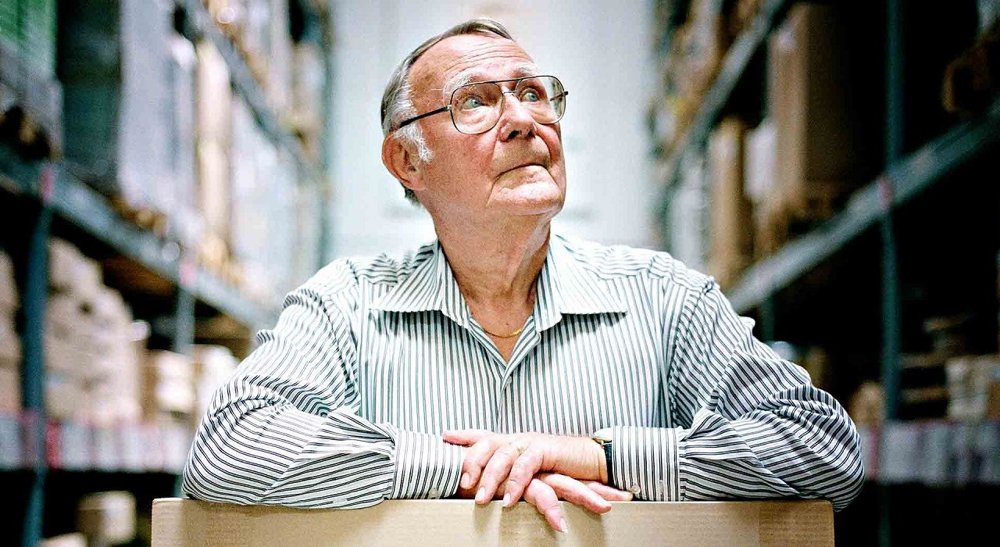From Matchsticks to Flat-Packs: The Origin Story of IKEA
From Ingvar Kamprad’s matchstick sales in rural Småland to pioneering mail-order catalogs, flat-pack furniture, and self-service stores, IKEA’s journey reshaped affordable design and built a global home-decor empire—all rooted in frugality and innovation.

Today, IKEA is a beloved global brand known for its maze-like showrooms, affordable modern furniture, and those flat-pack boxes we lug home. But the story of how this home-furnishings giant began starts far from any big city – on a small farm in southern Sweden nearly a century ago. This is the origin story of IKEA, a tale of a resourceful young boy who grew up to revolutionize the way the world decorates and furnishes its homes. It’s a journey filled with youthful entrepreneurship, innovative breakthroughs, big challenges, and bold ideas that forever changed home décor. Explore IKEA’s official timeline.
Let’s hop in our time machine and head back to 1920s Sweden, where our story begins.
The Farm Boy with Big Dreams (1920s–1930s)
Our story opens in the province of Småland, Sweden, where Ingvar Kamprad was born in 1926. He grew up on a farm called Elmtaryd near the tiny village of Agunnaryd – a rural upbringing that would later inspire the name IKEA (an acronym of Ingvar Kamprad Elmtaryd Agunnaryd). Småland was a rugged land of forests and frugal, hardworking people, where making the most of very little was a way of life. In this environment, Ingvar developed a keen business sense early on. By the age of five he was already selling matches to neighbors for a profit, having discovered he could buy them cheaply in bulk and sell them individually. Soon he expanded his tiny enterprise, bicycling around to sell Christmas cards, flower seeds, and pencils to local villagers. Those humble childhood ventures set the foundation for IKEA’s identity: a great deal paired with a friendly smile.
By his teens, Ingvar’s ambition had outgrown the farm. In 1943, at just 17 years old, he took a small sum his father gave him for doing well in school and officially founded a company called IKEA. At first, IKEA was a mail-order business selling small, easy-to-ship items—pens, picture frames, nylon stockings, wallets, and jewelry. He operated out of his family’s farm and even used the local milk truck to drop off packages. As demand grew, he began printing modest catalogs and flyers so people could browse and order remotely. Little did he know, this simple mail-order venture was planting the seeds for a retail revolution.
A New Direction: From Pens to Furniture (1940s)
For the first few years, IKEA sold everything except furniture. But in the late 1940s, after World War II, there was a big unmet need for affordable furniture in Sweden. In 1948, Ingvar introduced furniture into the IKEA product range—starting with a simple locally made dining table in birch. The response was overwhelming: customers loved the idea of well-designed pieces at prices far below city retailers. Encouraged by this success, Ingvar pivoted IKEA’s focus entirely to home furnishings by 1951, phasing out smaller sundries to concentrate on chairs, tables, and sofas. In 1950, he published the first annual IKEA Home Furnishing Catalog, a black-and-white booklet showcasing furniture offerings with descriptions and prices. View the original catalog archive. This catalog allowed people, even in remote villages, to discover IKEA’s products from home—and decades later would become one of the most widely distributed publications in the world.
First Showroom and Customer Confidence (1950s)
Of course, selling large items sight-unseen had its challenges. In 1953, Ingvar opened IKEA’s first showroom in the small town of Älmhult—a humble display room attached to a workshop. People could sit on a chair or examine a table, then place an order. This face-to-face interaction gave buyers confidence that low price didn’t mean low quality and provided invaluable customer feedback. Visit the IKEA Museum in Älmhult to see the original space where it all began.=

The Flat-Pack Revolution Begins (1950s)
As IKEA’s mail-order furniture business boomed, shipping bulky assembled pieces became expensive and risky. In 1956, an IKEA employee unscrewed the legs of a leaf-shaped coffee table so it would fit in his car—and realized customers could assemble furniture themselves at home. Later that year, IKEA introduced the LÖVET side table, its first flat-pack, self-assembly product, sold in a slim box with legs packed inside. Flat-packing dramatically reduced shipping costs and damage, and let customers transport items in small cars. This “you do yours, we do ours” model became a cornerstone of IKEA’s identity. Read how Smithsonian Magazine explores this innovation here.
Price Wars and Perseverance
By undercutting established dealers, IKEA provoked fierce backlash. Competitors pressured suppliers to boycott IKEA, and attempted to bar the company from trade fairs. But Ingvar was resourceful: when Swedish suppliers refused to sell, he designed IKEA’s own unique models and turned to foreign factories in Denmark and Poland. These partnerships allowed IKEA to source quality furniture at lower costs. The boycott only made IKEA stronger—forced innovation solidified its unique identity, and by the end of the 1950s, the scrappy company from Småland had become a real threat to the old establishment.
Opening the First IKEA Stores (1960s)
In 1958, Ingvar opened the first full-fledged IKEA store near Älmhult. It wasn’t fancy—more a warehouse-like space—but customers flocked to browse and take home purchases directly. Around the same time, he introduced an in-store café, realizing that well-fed customers linger—and shop—longer. Scandinavian meatballs became an unexpected delight and remain an iconic part of the IKEA experience.
In 1965, IKEA opened a flagship store in Kungens Kurva outside Stockholm—the largest furniture store in Northern Europe. Its circular, Guggenheim-inspired design guided visitors through every department. Ample parking catered to car-driving suburban families, and the store layout combined a showroom, marketplace, self-service warehouse, restaurant, and even a children’s play area. This blueprint became the modern IKEA big-box concept.
Turning Crisis into Innovation: The Self-Service Warehouse
A devastating fire at Kungens Kurva in 1970 forced a temporary warehouse setup during rebuilding. Customers loved picking their own flat-pack boxes directly off shelves. When the store reopened in 1971, the self-service warehouse was a permanent feature, slashing labor costs and turning shopping into a treasure hunt. Together with a one-way showroom layout, the self-serve model solidified IKEA’s retail formula.
In 1976, Ingvar published “The Testament of a Furniture Dealer,” a manifesto outlining IKEA’s values: frugality, simplicity, and “creating a better everyday life for the many people.” Read the full text here to see his guiding principles in his own words.

Spreading Across the Globe (1970s–1980s)
IKEA’s first international store opened in Norway in 1963, Denmark in 1969, then Switzerland in 1973 and Germany soon after. By the early 1980s, IKEA had stores in 20 countries. A unique franchising and ownership structure kept the company privately held and aligned with long-term goals.
In 1985, IKEA arrived in the United States near Philadelphia, Pennsylvania. American shoppers got their first taste of IKEA and embraced the flat-pack model. The store drew 150,000 visitors a week when it first opened—a testament to IKEA’s universal appeal. For a business-press perspective on that launch, see Forbes’ take on IKEA’s U.S. success.
A Lasting Legacy in Our Homes
From its humble beginnings in Småland to over 450 stores in more than 60 countries, IKEA’s journey is one of innovation, perseverance, and vision. Ingvar Kamprad, the farm boy turned billionaire, lived by frugality—driving an old Volvo and flying economy—to keep costs low and pass savings to customers. His flat-pack model, self-service stores, and Democratic Design philosophy reshaped the furniture industry forever.
Each IKEA piece in your home—from the trusty BILLY bookcase to a simple LANGSTED rug—carries a bit of Ingvar’s story: the belief that good design shouldn’t be reserved for the wealthy, and that with a little ingenuity (and some assembly), anyone can create a beautiful, functional space. As Ingvar said, IKEA’s aim was “to create a better everyday life for the many people.” His vision lives on every time someone says, “Let’s go to IKEA.”
Sources:
IKEA corporate history; Ingvar Kamprad’s memoir Leading by Design: The IKEA Story; various reputable biographies and archival records.
Further Reading
Quick facts
Is IKEA Chinese or Swedish?
IKEA is a Swedish company founded in 1943 by Ingvar Kamprad in Älmhult, Sweden. While IKEA sources products globally, its roots, design philosophy, and corporate headquarters remain Swedish.
What kind of store is IKEA?
IKEA is a home-furnishings retailer that combines a styled showroom with fully furnished room displays, a self-service warehouse for flat-pack pickup, and an in-store café—creating a one-stop, experiential shopping destination.
What type of company is IKEA?
IKEA is a privately held, franchised multinational retail company specializing in affordable home furnishings. It operates under Ingka Holding’s franchise network, structured to preserve its long-term vision and cost-conscious culture.
Why is IKEA so popular?
IKEA’s popularity stems from its blend of stylish, functional design and low prices, delivered through a unique flat-pack, self-assembly model and a memorable in-store experience that appeals to budget-conscious shoppers worldwide.
Is IKEA owned by Amazon?
No, IKEA is not owned by Amazon. It is an independent Swedish company founded by Ingvar Kamprad and operates its own franchise and logistics network.
Does IKEA do delivery?
Yes, IKEA offers home delivery services in most markets. You can choose curbside pickup, doorstep delivery, or in-home delivery—and even scheduled time slots—at checkout for an additional fee.
How much does IKEA Family cost?
IKEA Family is a free loyalty program. Members enjoy exclusive discounts, extended return windows, complimentary workshops, and special offers on food and events—all at no cost.
Does IKEA remove old furniture?
Yes, IKEA offers furniture removal services in many markets. For an additional fee, delivery teams can take away old furniture and packaging when they deliver your new items.
Does Amazon deliver for IKEA?
No, Amazon does not deliver IKEA products. IKEA uses its own delivery network or third-party carriers contracted directly by IKEA for home deliveries.
Does IKEA build your furniture?
Most IKEA products are sold in flat-packs for customer assembly at home using included instructions and basic tools. Paid assembly services are available at checkout for an additional fee.
Do I tip IKEA delivery?
Tipping IKEA delivery staff is not expected or required. Delivery teams are paid employees or vetted third-party contractors, so any gratuity is entirely voluntary.
Will IKEA deliver to my apartment door?
Yes, IKEA’s delivery options include doorstep delivery to your apartment door. You can select this service level during checkout, though availability may vary by location.
What is IKEA Family?
IKEA Family is a free membership program offering exclusive discounts, longer return periods, complimentary workshops, and member-only events in IKEA stores and online.
How do I return items to IKEA?
IKEA accepts returns within 365 days of purchase with proof of purchase. You can return items in-store or by mail; refunds are issued to the original payment method.
Does IKEA offer assembly services?
Yes, IKEA offers paid assembly services through authorized partners. You can add assembly to your order at checkout or schedule it via your local store’s service desk.

Geoff Abraham
Co-founder & President of Spoken
Geoff is the co-founder and President of Spoken. He is a Dad. He holds a BA from UT Austin (Plan II) and an MBA from Stanford. Geoff has built several successful businesses, including a bicycle taxi business in San Francisco which he ran for 10 years with his wife, Mimosa. He is an executive coach, and he actively invests in seed-stage startups via The Explorer Fund.
Read more